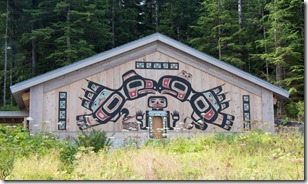Our usual practice upon departing Ketchikan after first arriving in Alaska is to start trying to fill the freezer with seafood. For us the easiest are prawns and crabs. We left Ketchikan the morning of Friday, May 12 and headed to Fitzgibbo…
Archive | M/V Alpenglow RSS feed for this section
Time to Move
The weather in the PNW this past winter and early spring has been poor (if we had been here for more than the one month since leaving AZ we’d probably use more colorful language). When a weather forecast showed up suggesting several days in a row of dry and not too windy days, we decided to high tail it out of town. At a civilized time of 0750 on Thursday, April 28 (the same departure day as last year), we cast off for out 2017 cruising season.
Our original thought was to leisurely work our way through the Strait of Georgia. We thought perhaps we’d visit Princess Louisa Inlet an offshoot of Jervis Inlet about 45 miles up the BC mainland coast from Vancouver. When, on our third night out, we were moored at the Thetis Island Marina we started to look at the weather and lay out the schedule. The extended weather forecast showed light winds along Johnstone Strait 3 and 4 days out. We’ve learned from previous trips that in early season, good traveling conditions are precious and ought not passed up casually.
After some quick discussion we pushed Princess Louisa to a future year and decided start moving. From Thetis Island we headed first to False Bay on Lasqueti Island in the Strait of Georgia than to Gowland Harbour on Quadra Island across from Campbell River. Because of the time of month, the slack before the ebb at Seymour Narrows wasn’t until about noon. Despite the leisurely start, we made Port Harvey on Cracroft Island. The next days travel brought us to Port McNeill our first (and only) BC provisioning stop.
We had a weather day in Port McNeill but then got a forecast we thought we could work with. An early start got us into Queen Charlotte Straits, then around Cape Caution. The seas were about what we expected (4-5 foot swells) but a long period so our paravane stabilizers worked very well. After 14 hours and 95 miles we called it quits for the day at Kisameet Bay.
The next day we fell in with Solstice, a fishing troller, traveling about the same speed as us. He was transmitting an AIS signal (as do we), so even though we were separated by several miles at time and barely visible, it felt like we were buddy boating. As we slogged up Graham Reach and headed to Khutze Inlet for the night (12 hours and 85 miles), Solstice pulled in shortly after us and dropped anchor a couple hundred yards away. We chatted on the radio later and learned that they were a semi-retired couple (Dan and Marsha) from Gig Harbor. The next morning we left about ten minutes after them and followed them up Grenville Channel and into Kelp Passage Cove (12 hours and 89 miles).
During this time the weather has been cool and rainy but the winds not too bad. They occasionally would bump up to the upper teens but would usually be from behind and not a problem. Both Solstice and ourselves are seeing good conditions developing for crossing Dixon Entrance and are motivated to push the mileage to make sure we hit it.
From Kelp Passage, we again leave shortly before dawn right behind Solstice and follow them across Dixon Entrance in some of the best conditions we’ve ever had. At this point we parted ways as Solstice continued to Ketchikan (for another 95 mile day) and we pull up short at Foggy Bay (a leisurely 9 hour 64 mile day). Dan & Marsha were needing to get to Petersburg where they’d leave the boat while they fly home. We agreed to look for each other on AIS later in the season and hopefully actually meet in person.
An early departure from Foggy Bay gets us to Ketchikan a little before 10 AM on Wednesday, May 10. Because we’ve arrived in Alaska early there is enough time to do a swing through Behm Canal and still go to Petersburg for a few days of the Little Norway Festival.
Trying to Get Ahead of the Game
Things are always breaking on a boat. The boat must supply all of the services necessary for comfortable living (e.g., electricity, heating, potable water, waste disposal) plus be capable of propelling itself and offer sufficient information for safe navigation. The fact that you are floating in salty solution that encourages the corrosion of everything it touchs only adds to the opportunities for failure.
As part of our annual pre-cruise work list of fixes and enhancements, we decided to replace some items that had not failed but, based on their age, were likely to fail soon. Wanting to have the work down right and in a timely fashion, we decide to pay people more skilled then we are.
We left Sunday, April 9 and motored up to Port Townsend to begin our journey of spreading money around the communities of the Salish Sea. Port Townsend Shipwrights Coop did the lions share of the work.
One item was the generator exhaust elbow where cooling water from outside the boat is sprayed into the hot exhaust gases from the fuel’s combustion. When it was removed, it showed some minor external corrosion and had buildup of “gunk” which can lead to exhaust back pressure and more serious problems.
After leaving Port Townsend, we headed up to Prevost Harbor on Stuart Island in the San Juan Islands for a couple of nights at anchor. We crossed paths with Peter Geerlofs the owner of “cousin” vessel Diesel Duck, SeaDucktress. We encountered Peter frequently during last years SE Alaska cruise.
We headed into Anacortes on Sunday, April 16 where the next day, we were having a new water heater installed by Marine-Tec, the folks who installed our furnace. When the old water heater was pulled, corrosion was starting to eat away the inlet pipes so we were glad we had acted. The new water heater, a 15 gallon Solaris, is certainly a step up from the old unit (an 11 gallon Kuuma) and we are looking forward to long service and ample hot water.
Our last stop was a swing down to Des Moines Marina where we topped off our fuel tanks in preparation for departing the following week.
Annie-Cat – In Memoriam
We had been expecting and dreading this day since this last rainy Memorial Day weekend in Petersburg when it became pretty apparent that our cat Annie was failing on account of kidney failure. We visited the vet with the expectation that she would be euthanized that day.
 Instead, with the encouragement of the veterinarian, Dr Ken Hill, we started a program of subcutaneous infusion of Ringers Lactated Solution for hydration. It made a dramatic improvement in Annie and she ably completed this seasons cruse.
Instead, with the encouragement of the veterinarian, Dr Ken Hill, we started a program of subcutaneous infusion of Ringers Lactated Solution for hydration. It made a dramatic improvement in Annie and she ably completed this seasons cruse.
But all along, we knew it was only postponing the inevitable. Her weight continued to drop (our Bainbridge vet thought perhaps lymphoma was in play as well) and she was no longer tolerating the regular 2 to 4 minute subcutaneous infusions we tried to perform.
For any pet owner (or whatever the more current euphemism might be) there comes the time to recognize that additional care is not really increasing the quality of the pet’s life. After 4-1/2 months of care since  that rainy weekend, we decided that Annie was failing rapidly and the best course was to euthanize her.
that rainy weekend, we decided that Annie was failing rapidly and the best course was to euthanize her.
We had Annie (short for Annapurna) since she was a kitten over 14 years ago. She accompanied us as one of two ship’s cat (Maggie was the other) on every significant cruise we did on our boats. She was always affectionate, fastidious in her litter habits and had the world’s softest fur. We’ll miss her very much.
Where we went in 2016
Below is a map of the locations that we visited during our 2016 cruise. If you click on one of the map symbols, the name of the location and some descriptive text are shown. To open the map in a separate window click on Cruise 2016
Port McNeill to Bainbridge Island – Home Again, Home Again
It had been a long time since we washed the boat and dirt & salt had been accumulating on the boat in our travels. Our expected thorough exterior washing in Port McNeill was halted by the water restrictions at the marina due to dry conditions in the water shed.
 Since we had time in Port McNeill while waiting for guests to arrive, we headed over to Sointula on Malcolm Island, a short ferry ride away. It immediately rose in our estimation with a tasty bakery at the head of the ferry dock. With the town having a strong Finish heritage, lots of butter was used in the pastries. We only spent a few hours checking out recreational opportunities and the marina but decided we ought to visit the community again on a future trip.
Since we had time in Port McNeill while waiting for guests to arrive, we headed over to Sointula on Malcolm Island, a short ferry ride away. It immediately rose in our estimation with a tasty bakery at the head of the ferry dock. With the town having a strong Finish heritage, lots of butter was used in the pastries. We only spent a few hours checking out recreational opportunities and the marina but decided we ought to visit the community again on a future trip.
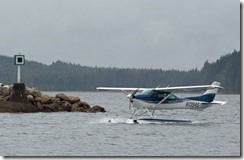 Our friends, Natala and Don Goodman flew into Port McNeill in their own Cessna 182 equipped with floats. Don is a longtime climbing friend and when he retired from Boeing, he purchased the airplane as his means of continuing to explore and visit new places. The weather was a bit blustery when they arrived but Don expertly put the plane down outside the breakwater and docked it in the marina.
Our friends, Natala and Don Goodman flew into Port McNeill in their own Cessna 182 equipped with floats. Don is a longtime climbing friend and when he retired from Boeing, he purchased the airplane as his means of continuing to explore and visit new places. The weather was a bit blustery when they arrived but Don expertly put the plane down outside the breakwater and docked it in the marina.
On Tuesday, August 30, the day after they arrived we headed out into the Broughtons for a few days. The first night we anchored next to Blair Islet in MacKenzie Sound. We dropped prawn pots on the way in hoping to offer up fresh seafood in a meal.
The next morning, on the way out we retrieved the three pots and had enough prawns to feature in the night’s main course. We traveled through the inner channels in the Broughtons and made our way to Waddington Bay on Bonwick Island for the night. The weather was nice enough that we dropped the kayaks for a paddle around the bay.
 We returned the following morning, September 1, to Port McNeill. Don & Natala were wanting to continue the journey flying north along the BC coast than cutting into the interior to visit a friend in northern BC. The rest of the day, Don spent researching the route, checking weather and calling to confirm the availability of services along the way.
We returned the following morning, September 1, to Port McNeill. Don & Natala were wanting to continue the journey flying north along the BC coast than cutting into the interior to visit a friend in northern BC. The rest of the day, Don spent researching the route, checking weather and calling to confirm the availability of services along the way.
The next day, Friday, September 2, Marcia and I left Don and Natala in Port McNeill waiting for the weather to shape up along their intended route. We continued our journey south down Johnstone Strait. We anchored the night in Port Neville.
 On Saturday, we left the anchorage at a leisurely 11 am in order to catch the building flood current in Johnstone Strait. We raced through the channels with the current and anchored the night in Owen Bay on Sonora Island. The sunset was particularly stunning that evening on account of the interplay of low angle sunlight and patchy clouds.
On Saturday, we left the anchorage at a leisurely 11 am in order to catch the building flood current in Johnstone Strait. We raced through the channels with the current and anchored the night in Owen Bay on Sonora Island. The sunset was particularly stunning that evening on account of the interplay of low angle sunlight and patchy clouds.
An early start on Sunday, September 4, to catch the slack before the ebb got us through Upper Rapids and Hole-in-the-Wall quickly. We made our way to the very popular Prideaux Haven anchorage in Desolation Sound and squeezed ourselves into a spot. Since we arrived pretty early in the day, after lunch we had a nice paddle through the anchorage and into the next anchorage east.
The forecast on Labor Day had the winds out of the SE picking up in the afternoon so we got an early start. Conditions were good until near Powell River when the winds picked up to the mid teens. As we entered Malaspina Strait the winds bumped up to the low 20’s and the seas became higher and steeper. Soon we were pounding along, barely able to average 5 knots. The cats quickly emptied their tummies and hunkered down for the grind. With much relief, we reached the calm conditions in Pender Harbour and made our way into the south part, Gerrans Bay. Remarkably, when I recorded our position in the ship’s log, I noticed it was the exact spot, to one-thousandths of a minute of arc (about 6 feet), that we had anchored on the way north this year. I could never repeat that performance even if I tried.
Weather conditions the next morning, September 6, were the exact opposite and we had pleasant crossing of the Strait of Georgia, through Porlier Pass and anchoring in Montague Harbour on the north side of the Gray Peninsula.
 We crossed back into the United States on Wednesday, September 7. We anchored in Reid Harbor on Stuart Island. We stayed two days here, doing the short loop around the camp area the first day and the longer walk to the Turn Point Lighthouse the second day.
We crossed back into the United States on Wednesday, September 7. We anchored in Reid Harbor on Stuart Island. We stayed two days here, doing the short loop around the camp area the first day and the longer walk to the Turn Point Lighthouse the second day.
On Friday, September 7 we traveled the 10 miles to the Deer Harbor Marina on Orcas Island where our yacht club has leased dock space for use as an outstation. Marcia did a couple of loads of laundry that afternoon while did some boat chores. We left time for ice cream cones from the marina store. The next day we borrowed the marina van to drive to Eastsound and did some shopping. Being Saturday, there was a Farmer’s market where Marcia purchased the most luscious tomatoes ever.
A special treat for us that afternoon was a visit by Kathleen & John Douglas, owners of MV Laysan, a sistership to ours. When we were in Reid Harbor, we chatted with the owners of a vessel on the dock who mentioned they had seen a vessel exactly like ours on Sucia Island. I texted the Douglas’s and we worked out the rendezvous.
On Sunday morning, we headed out to Echo Bay on Sucia Island. The weather was sunny and a bit breezy, but that didn’t stop us from paddling our kayaks to shore and doing walks along the trails that stretch across the island on both days we were anchored.
On Tuesday morning, we headed to Cap Sante Marina in Anacortes. We stopped first at the fuel dock where we added 785 gallons of diesel. The only other time we fueled was in Juneau on July 1 where we added 420 gallons. We’ll top off the tanks next Spring before starting the 2017 cruise.
A predawn start the next morning, Wednesday, September 14 got us into the ebb current down Rosario Strait and allowed us to catch the building flood down Admiralty Inlet. We arrived back in Eagle Harbor shortly after 3 pm, 20 weeks after we left on Wednesday, April 27.
We spent 99 nights at anchor (71%), 40 nights at a dock and one night on a mooring ball. This years cruise was 3979 nautical miles long with exactly 700 hours of engine operation. Backing out the 68.6 engine hours devoted to sightseeing or fishing (trolling, drifting or prawning), our average speed was 6.3 NM/hr. This speed is measured from starting the engine at anchor or dock until stopping the engine at anchor or dock. We ran the genset for 51.9 hours.
Prince Rupert to Port McNeill – “The long way home” – Part 2
 The morning of August 16 we left Shearwater Marina for Codville Lagoon, dropping prawn pots before we anchored. Since it was still early, we dropped the kayaks into the water and paddled to shore. We then hiked 2 km trail to Sagar Lake and its lovely sandy shores.
The morning of August 16 we left Shearwater Marina for Codville Lagoon, dropping prawn pots before we anchored. Since it was still early, we dropped the kayaks into the water and paddled to shore. We then hiked 2 km trail to Sagar Lake and its lovely sandy shores.
After picking up our prawn pots (enough for a meal or two) on the way out, we headed down to fish outside Gold Stream Harbor. We’ve anchored there in the past but the forecasted strong westerly winds persuaded us to continue further south after fishing (unproductive) to Fish Egg Inlet. We dropped prawn pots part way in then worked our way to the very back and anchored in the shallow waters of Oyster Bay.
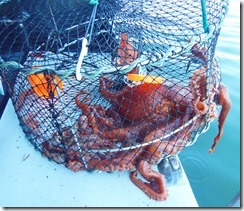 The next morning, August 18, we headed out to fish Addenbroke Island where we had seen lots of guide sport fishing boats the day before. They were there when we arrived and we joined the melee, a blundering 50’ goliath amongst more agile 20’ davids. While Marcia got some good hits on her gear there was no firm bite. We stopped to pull our prawn pots as went back into Fish Egg Inlet to anchor. The first pot had a nice haul of prawns, the second pot felt equally heavy as we pulled it in but its heft came from an octopus in it surrounded by prawn carcasses. We opened the pot and let the octopus ooze its way back into the water.
The next morning, August 18, we headed out to fish Addenbroke Island where we had seen lots of guide sport fishing boats the day before. They were there when we arrived and we joined the melee, a blundering 50’ goliath amongst more agile 20’ davids. While Marcia got some good hits on her gear there was no firm bite. We stopped to pull our prawn pots as went back into Fish Egg Inlet to anchor. The first pot had a nice haul of prawns, the second pot felt equally heavy as we pulled it in but its heft came from an octopus in it surrounded by prawn carcasses. We opened the pot and let the octopus ooze its way back into the water.
We were concerned with the third pot as the line was initially snagged on the bottom but we ultimately retrieved it and its load of prawns to the surface. We reset the pots but in a location a distance away from where we returned the octopus. For the night we anchor in a cove south of a passage called “The Narrows”.
 After the excitement of the day before, when we pull pots we aren’t sure what to expect. The first two pots had a good number of prawns but the third one we pulled up had another octopus. This octopus was a bit smaller than the previous days catch and we quickly returned him to the water. We decided to give this area a rest and did not reset the prawn pots. We first fished Addenbroke where we had two good hooks but Kurt botched the netting at the swim step on the first fish and the line at the hook broke on the second one. We headed off next to Gold Stream to fish the afternoon bite. After a couple of hours trolling (and not seeing any other boats fishing), we conclude
After the excitement of the day before, when we pull pots we aren’t sure what to expect. The first two pots had a good number of prawns but the third one we pulled up had another octopus. This octopus was a bit smaller than the previous days catch and we quickly returned him to the water. We decided to give this area a rest and did not reset the prawn pots. We first fished Addenbroke where we had two good hooks but Kurt botched the netting at the swim step on the first fish and the line at the hook broke on the second one. We headed off next to Gold Stream to fish the afternoon bite. After a couple of hours trolling (and not seeing any other boats fishing), we conclude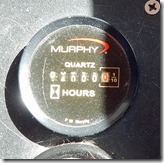 the fish aren’t here. We head to Pruth Bay for the night. As we make our way there, we watch our engine hour gauge roll over another thousand hours of operation to 4,000.
the fish aren’t here. We head to Pruth Bay for the night. As we make our way there, we watch our engine hour gauge roll over another thousand hours of operation to 4,000.
 Figuring that Addenbroke Island is “the” place for fishing, we head back there on Saturday, August 20. After several days of no fish caught, Marcia hooks and brings up a nice size coho salmon. We call it a day and head to Green Island to anchor. After the fish is cleaned and fileted, we drop the kayaks and paddle around this delightful anchorage.
Figuring that Addenbroke Island is “the” place for fishing, we head back there on Saturday, August 20. After several days of no fish caught, Marcia hooks and brings up a nice size coho salmon. We call it a day and head to Green Island to anchor. After the fish is cleaned and fileted, we drop the kayaks and paddle around this delightful anchorage.
 We had been monitoring weather for crossing around Cape Caution, one of the few sections of the Inside Passage with prolonged exposure to ocean swells and conditions. We decided that Monday, August 22, looked like good conditions. On August 21, we first fished Addenbroke Island where Marcia caught one more coho salmon then we headed into Fury Cove to join the other boats waiting to cross.
We had been monitoring weather for crossing around Cape Caution, one of the few sections of the Inside Passage with prolonged exposure to ocean swells and conditions. We decided that Monday, August 22, looked like good conditions. On August 21, we first fished Addenbroke Island where Marcia caught one more coho salmon then we headed into Fury Cove to join the other boats waiting to cross.
The next morning, August 22, started off nicely but the NW wind did pick up as the day progressed. We put our stabilizing fish in the water to reduce the boat’s rolling motion caused by ocean swell which it did nicely. Our original intent was to stop at Blunden Harbor but when we started to go in, the wind was brisk enough that there were white caps in the anchorage so we continued on. We ended up in Napier Bay on N Broughton Island which was very calm but not particularly scenic on account of past logging activity.
The next day we headed into Drury Inlet and make our way to Jennis Bay Marina. Considerable logging has taken place in the area which offer logging roads on which to walk so we did a 5 mile round trip hike to a vista overlooking Drury Inlet and Jennis Bay. At happy hour we were able to meet the other boaters on the dock, a treat you can’t easily do if your anchored out (especially you are by yourself).
The Broughtons are a compact area so it was a short day to the next anchorage in Burly Bay in MacKenzie Sound. A dramatic cliff stands above the anchorage.
On Thursday, August 25, we worked our way along the inside channels to the cozy and quiet anchorage in Lady Boot Cove (aka “East of Eden Cove”) on Eden Island. It is ony a 1 or 2 boat anchorage and you have no visibility as to whether anyone is in it until you are almost in. We had it to ourselves for the night.
We completed this leg of our journey the next morning when we traveled through the thick fog blanketing Queen Charlotte Strait to Port McNeill arriving late morning on August 26, 23 days after leaving Prince Rupert
Prince Rupert to Port McNeill – “The long way home” – Part 1
After celebrating Marcia’s birthday at the Cow Bay Café, we continued the next leg of our journey south by heading over to Edye Pass on the north side of Porcher Island and fishing the afternoon slack. Marcia got her first Canadian coho salmon of the season before we headed into Hunt Inlet for the night.
The next day, August 4, we made the trek down Ogden and Petrel Channels towards Principe Channel. We were continually surprised at the remarkable changes in our speed over ground due to eddies and back eddies as we went around the many points and bends in Petrel Channel. As we entered Principe Channel, we encountered the forecast NW winds of 20-25 knots. We ferried 2 miles across Principe Channel and anchored for the night in Colby Bay.
 On August 5, we did a short day and went to the north cove of Patterson Inlet, also know as Princess Diana Cove. It was an extraordinarily lovely anchorage, land locked with steep mountains on two sides and lower hills on the other two. We dropped the kayaks down and paddled around the anchorage.
On August 5, we did a short day and went to the north cove of Patterson Inlet, also know as Princess Diana Cove. It was an extraordinarily lovely anchorage, land locked with steep mountains on two sides and lower hills on the other two. We dropped the kayaks down and paddled around the anchorage.
The next day was devoted to fishing, stopping first in Otter Channel for the early slack, then heading up to the NW corner of Gill Island for the afternoon. The salmon successfully eluded Marcia at both although there were some good hits at the lure. We anchored in Hawk Bay on Fin Island for the night.
August 7 was another fishing day with the early bite being at Money Point at the south tip of Hawkesbury Island and the afternoon bite again at the NW corner of Gill Island. Marcia released 2 pink salmons but no coho salmon were caught. The very convenient Hawk Bay was again the anchorage.
 We headed out the next morning for Laredo Channel, stopping first at Ulric Point for a little fishing. Marcia managed to coax a salmon into remaining hooked (the Canadian fishing regulations require barbless hooks for salmon fishing) so we didn’t come away empty handed. Our destination for the night was Alston Cove in Laredo Inlet, a very lovely anchorage.
We headed out the next morning for Laredo Channel, stopping first at Ulric Point for a little fishing. Marcia managed to coax a salmon into remaining hooked (the Canadian fishing regulations require barbless hooks for salmon fishing) so we didn’t come away empty handed. Our destination for the night was Alston Cove in Laredo Inlet, a very lovely anchorage.
We continued our explorations in Laredo Inlet the next day, first looking for some halibut fishing areas which proved to be illusory, then dropping some prawn pots outside the Bay of Plenty (a promising name!) where we anchored for the night.
The next morning, August 10, we pulled the first pot with some hopeful expectations which were dashed when we found the pot was totally bare of sea life even though the bait (salmon belly and herring) were stripped clean. Our expectations now set appropriately, the next two pots did not disappoint when they too were barren. We continued to the head of Laredo Inlet, which was lovely but had no suitable anchorage so we turned around retraced our path out. We timed our exit to fish the entry just north of Hastings Island. Marcia reeled in a lovely coho salmon for the effort. Our anchorage for the night was Meyers Narrow Cove just off of Meyers Passage.
 An early start the next day saw us through Meyers Narrow at slack and then through Milbanke Sound and into Seaforth Channel before the forecasted afternoon winds started. We fished Idol Point along the way and Marcia was blessed with two coho salmon for her efforts. We had a lovely afternoon and night anchored in Wigham Cove.
An early start the next day saw us through Meyers Narrow at slack and then through Milbanke Sound and into Seaforth Channel before the forecasted afternoon winds started. We fished Idol Point along the way and Marcia was blessed with two coho salmon for her efforts. We had a lovely afternoon and night anchored in Wigham Cove.
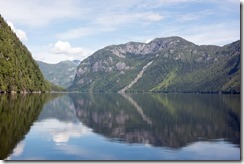 On Friday, August 12, we first headed over to Shearwater Marina hoping to be able to get moorage for the night. Being high season for the area, the docks were full so we made reservations for the following Monday. With time on our hands, we cruised up Roscoe Inlet, a spectacularly beautiful channel carved out by a glacier. It would be even nicer in early season when snow melt from higher elevations cascaded down the steep rocky slopes. We anchored at the very end sharing it with a sailboat.
On Friday, August 12, we first headed over to Shearwater Marina hoping to be able to get moorage for the night. Being high season for the area, the docks were full so we made reservations for the following Monday. With time on our hands, we cruised up Roscoe Inlet, a spectacularly beautiful channel carved out by a glacier. It would be even nicer in early season when snow melt from higher elevations cascaded down the steep rocky slopes. We anchored at the very end sharing it with a sailboat.
Our explorations continued the next day when we exited Roscoe Inlet and headed up Spiller Inlet. The views were not as nice as t he surrounding slopes were less steep and obvious signs of recent and ongoing logging marred them. We anchored the night in the east cove of Ellerslie Bay.
he surrounding slopes were less steep and obvious signs of recent and ongoing logging marred them. We anchored the night in the east cove of Ellerslie Bay.
The next morning, we headed to Idol Point where Marcia again caught two coho. Idol Point was the obvious hot spot as close to a dozen boats were fishing the area. For our anchorage, we headed to Discovery Cove on Cunningham Island.
On Monday, August 15, we traveled the short distance to Shearwater, where after a brief wait, we got onto the dock and proceeded to do chores (laundry and an oil change) and some light provisioning.
(To be continued)
Craig to Prince Rupert
We decided to bypass Ketchikan on our way out of Alaska this year. From Craig headed SE. We hit three new (to us, anyway) anchorages, Shelikof Island Cove, Mabel Bay and Hunter Bay in successive nights then headed for Hydaburg.
Hydaburg is primarily populated by members of the Haida native Alaskan clans. Cruising friends of ours had recommended Hydaburg to us for its native culture and friendly community. The last week of July they have Haida Culture Camp intended to spread and preserve Haida culture in the community. It is open to the public and we attended classes one day and then the closing feast event. The foundation for a new long house to be used in Haida cultural events was dedicated while we were there. We were terrifically impressed by the community spirit and the efforts they are going through to preserve their culture.
After Hydaburg, we sneaked around Cape Chacon and spent the night in Gardner Bay. It is to far (at least at our leisurely speeds) to make it to Prince Rupert in one day from the south tip of Prince of Wales Island. Instead, we crossed Clarence Strait, scooted around the north side of Duke Island and made our way to the mainland side of Revillagigedo Channel. Our last night in Alaska for 2016 was in Foggy Bay, the same anchorage we used for our first night this year.
An early start the next morning, the first day of August, got us into Prince Rupert at the Prince Rupert Rowing & Yacht Club (PRRYC) by 1 PM (and that is with losing an hour going from AKDT to PDT). We’ll spend a couple of nights in Prince Rupert before continuing the slow journey south. Our rough schedule has us rounding Cape Caution, the exposed section that separates the northern portion of the BC Inside Passage from the southern portion, towards the end of August.
Hoonah to Craig
Our stay is Hoonah was pleasant. The store grocery and hardware store are well stocked and a new craft brewery with a tasting room has opened up. We had an interesting conversation with the master carver for the panels in and on the Huna Tribal Long House being built in Glacier Bay National Park at Bartlett Cove. The exterior panel (left photo) is complete and installed on the long house but the interior panel (right photo) was in the final stages of completion at the carving shop in Hoonah before being shipped off for the dedication on August 25.
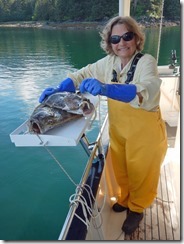 After two nights on the dock, we untied and headed east in Icy Strait then headed south down Chatham Strait. The weather was lovely and along the way we stopped in Iyoukeen Cove and fished for halibut. After about 2 hours effort, Marcia had 2 halibut aboard. She cleaned them after we arrived in our anchorage for the night, Pavlof Harbor.
After two nights on the dock, we untied and headed east in Icy Strait then headed south down Chatham Strait. The weather was lovely and along the way we stopped in Iyoukeen Cove and fished for halibut. After about 2 hours effort, Marcia had 2 halibut aboard. She cleaned them after we arrived in our anchorage for the night, Pavlof Harbor.
After the previous lovely day we were expecting more of the same but Chatham Strait fooled us by 15-20 knot head winds and a steep 3’ choppy head seas. Both cats lost their breakfast in the subsequent pounding. We pulled into Takatz Bay and found our “cousin” ship (same builder and hull design but different upper layout), Luck Dragon, already anchored. We had last seen Ed and Carlene in Sitka nearly a month earlier.
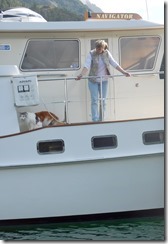 Next day, we continued down Chatham Strait in calm conditions to Gut Bay which we had visited previously this season. There was a bit of wind across the bay so we anchored in a protected cove on the bay’s south side that is outside a small cove with a shallow entrance requiring it to be timed. We dropped the kayaks and paddled into the inner cove and found a vessel, Navigator, anchored their owned by friends of the our neighbors in the marina at which our boat stays for the winter. Lynn & Neal cruise with 3 Maine Coon cats so we, of course, have an affinity with them.
Next day, we continued down Chatham Strait in calm conditions to Gut Bay which we had visited previously this season. There was a bit of wind across the bay so we anchored in a protected cove on the bay’s south side that is outside a small cove with a shallow entrance requiring it to be timed. We dropped the kayaks and paddled into the inner cove and found a vessel, Navigator, anchored their owned by friends of the our neighbors in the marina at which our boat stays for the winter. Lynn & Neal cruise with 3 Maine Coon cats so we, of course, have an affinity with them.
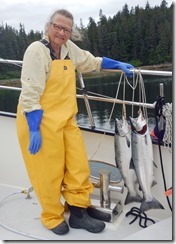 Our original hope was to continue around Cape Decision at the south end of Kuiu Island but between the weather forecast and our desire to minimize stress on the cats, we decided to go around the north end of Kuiu Island and down Rocky Pass (Keku Strait). Along the route, we stopped and fished Kingsmill Point where Marcia found two coho salmon attracted to her fishing lure. Marcia cleaned her catch in Honey Dew Cove on the north end of Kuiu Island.
Our original hope was to continue around Cape Decision at the south end of Kuiu Island but between the weather forecast and our desire to minimize stress on the cats, we decided to go around the north end of Kuiu Island and down Rocky Pass (Keku Strait). Along the route, we stopped and fished Kingsmill Point where Marcia found two coho salmon attracted to her fishing lure. Marcia cleaned her catch in Honey Dew Cove on the north end of Kuiu Island.
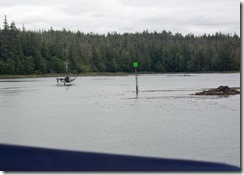 Transiting Rocky Pass is not difficult but does require attention to timing (high slack water at the Devil’s Elbow station) and to navigation. There are about 40 navigation aids but the number of hazards far exceeds that. You tend to rely on your electronic navigation to show where you are and do your best to relate what you see outside with what the screen says. We ended up following a commercial troller and being followed by another pleasure craft through the tricky part.
Transiting Rocky Pass is not difficult but does require attention to timing (high slack water at the Devil’s Elbow station) and to navigation. There are about 40 navigation aids but the number of hazards far exceeds that. You tend to rely on your electronic navigation to show where you are and do your best to relate what you see outside with what the screen says. We ended up following a commercial troller and being followed by another pleasure craft through the tricky part.
Continuing the inside water route to Craig, we went through El Capitan Passage, spending the night in Kaguk Cove before heading into Craig.
While in Craig, we bumped into some cruisers from the Bremerton Yacht Club that we had also met in 2014 while in Icy Strait. They had been doing some serious fishing in Craig so Marcia pumped them for local knowledge.
 After two nights in Craig we headed out to do some fishing. There is lots of commercial fishing, both trollers and seiners so Marcia was hoping for something. She did catch two pink salmon but both ultimately got away. After one night out, we decided to sit out some upcoming windy & rainy weather at the dock and so headed back into Craig.
After two nights in Craig we headed out to do some fishing. There is lots of commercial fishing, both trollers and seiners so Marcia was hoping for something. She did catch two pink salmon but both ultimately got away. After one night out, we decided to sit out some upcoming windy & rainy weather at the dock and so headed back into Craig.
From here, our plan is to visit Hyderburg for a few days during their annual native cultural event. Than we’ll continue around the south end of Prince of Wales Island and make our way across the border to Prince Rupert, BC.


